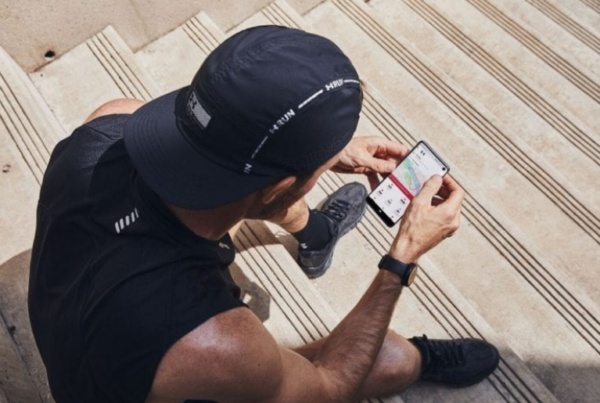Despite being such a simple sport on paper, there are more than a few long-standing debates in the running scene. Are compression socks good for recovery? Should you use ice or heat after a run? One topic, however, seems to reign supreme when it comes to running controversies: What is the “perfect” running form? Does such a thing even exist?
It makes sense — with body mechanics and paces varying from runner to runner, the optimal running form has historically been difficult to nail down. Take a look at even the most elite athletes; there are differences between Meb Keflezighi’s form and Lawrence Cherono’s form, and both have won the Boston Marathon.
Under Armour has tackled this issue in its latest collaboration with Samsung on the new Galaxy Watch Active2 Under Armour Edition. After years of research and development, they’ve taken the stance that optimizing your running gait (specifically cadence) is not only important, but also coachable.
WHAT IS CADENCE AND WHY DOES IT MATTER?
While there are several different components of an individual’s running form, cadence has one of the greatest impacts on overall running economy (which is akin to efficiency). Cadence is essentially defined as steps per minute, which you’ll often see abbreviated as SPM. If you multiply cadence (steps/minute) and stride length (distance/step) you get distance/minute, which translates to speed. Ideally, as Under Armour has discovered, there is a cadence “sweet spot” for every runner.
“Under Armour defined a runner’s cadence target through a multi-month research initiative that involved data scientists, exercise scientists and running coaches. The breakthrough can really be attributed to large data sets,” says Jeff Knight, Under Armour’s senior manager of digital product science. “After the initial formula was created, it was vetted against elite athletes and coaches. The end result is a highly personalized cadence target that changes with pace and varies with physical characteristics.”
This cadence target differs based on a number of factors, including a runner’s gender (women tend to have a higher cadence than men), height, weight, age and pace. It’s also important to note that while runners should strive for a consistent cadence (especially outdoors), most people tend to lower their cadence on a treadmill, while running uphill and when fatigued.
- READ MORE > 6 MISTAKES BEGINNER MARATHONERS NEED TO AVOID
FORM COACHING IN ACTION
UA’s data showed many runners tend to overstride, meaning the runner takes steps that are too long for their given pace. This may cause not only a decrease in running economy (making the run feel harder), but may also lead to unnecessary force with each footfall.
“Our goal with form coaching was to give the runner personalized feedback that helps them identify their personally optimized running form, which unlocks a performance advantage and helps runners manage their risk of injury,” says Ben McAllister, senior director of product for MapMyRun.
With this in mind, the Galaxy Watch Active2 Under Armour Edition provides form and fitness coaching to correct cadence in real-time. Runners can use data from the watch itself — or pair it with one of UA’s connected running shoes — to see visual feedback and hear audio cues during workouts to help them improve their stride and maintain their pace. Using UA’s connected shoes during a run allows a runner to gain access to stride length and increases the accuracy of the individual’s workout data.
“As you run, we calculate your optimal target range for cadence, and as your speed changes, this target range also changes. At any point during your run [after a one-minute warmup period], we are telling you how to optimize your stride,” says McAllister. “We visualize this on the watch so that you can see your current cadence relative to your target zone, and we also alert you with audio cues and haptic feedback periodically when you are out of your zone.”
McAlister notes that the team designed the coaching cues to not alert a runner too frequently — even when he or she is out of the optimal zone — because they didn’t want the feedback to get in the way of the run.
Once a run is completed, the MapMyRun app shows an in-depth form analysis that includes what percentage the athlete spent in their targeted range and provides detailed coaching tips to focus on during their next run.


HOW BEGINNERS CAN BENEFIT FROM FORM COACHING
It may come as no surprise that a runner who is just getting into the sport will glean different insights from form coaching than more advanced runners. As mentioned above, many beginners tend to overstride, which may decrease running economy and increase the likelihood of injury. This means beginner runners stand to gain instant benefit by learning about their cadence, comparing it to their target range and getting tips on how to improve.
“These individuals should aim to adjust their cadence into the target zone on easy-effort runs. Adjust it for a few minutes at a time, and slowly increase the amount of time running in the target zone over the course of a few weeks,” says Knight.
Another benefit of form coaching for a beginner is realized when he or she nails their ideal cadence, thus potentially improving his or her running economy. When a runner is more economical, running will likely feel much easier. When running feels easier, that runner is much more likely to create and stick with this healthy habit. Furthermore, research shows that a higher cadence decreases the force a runner feels with each step, which may have a positive effect on the chances of being sidelined and backtracking on progress.
BENEFITS FOR MORE ADVANCED RUNNERS
Advanced runners approach training with a more complete toolset and knowledge base gained through miles of experience. Not only will they find value in checking their cadence against their target zone at their easy running pace (they’ll likely already be in their target zone), but there are three conditions where the real-time form coaching feature is especially useful.
First, form coaching is helpful during important training sessions such as interval workouts, tempo/LT (lactate threshold) runs or race-pace efforts.
“Many advanced runners may find, even though their cadence may be in their target zone on easy runs, their cadence is out of the target at fast, uncomfortable paces,” says Knight. “Advanced runners spend less time running these paces and they often push themselves at these paces during peak sessions. Inexperience or discomfort at these paces may cause them to adopt a less-than-optimal cadence.”
Next, real-time form coaching is a helpful reminder when the athlete is tired at the end of a long or medium-effort run. These might include steady-state, anaerobic, threshold, LT or tempo runs.
Lastly, advanced runners may find they are out of their target range at the beginning of runs due to being sore. This is part of a larger discussion about proper warmup and recovery methods, but real-time feedback is an effective way to promote proper form early in a session.
THE BOTTOM LINE
Whether you’re a beginner, more experienced or somewhere in between, form coaching could have a major impact on your running economy. While no two runners’ gaits will look alike, Under Armour’s in-depth research points to the importance of an ideal, personalized cadence range. After all, even the pros want running to feel easier, so why wouldn’t you?









